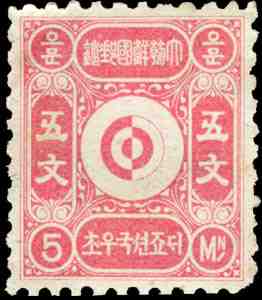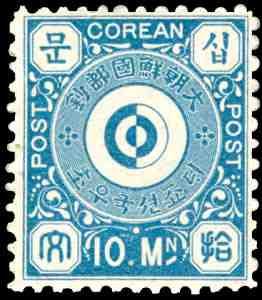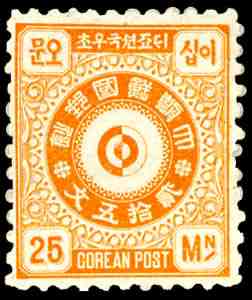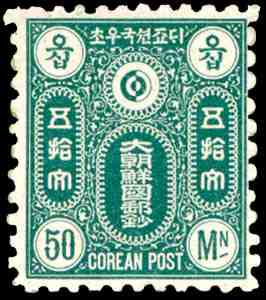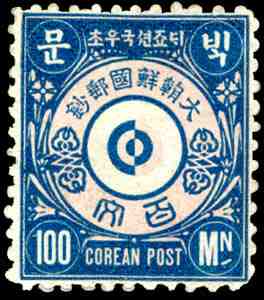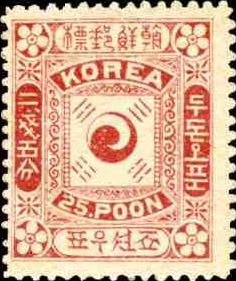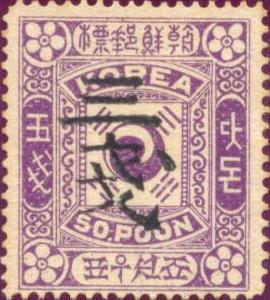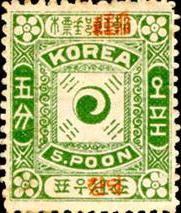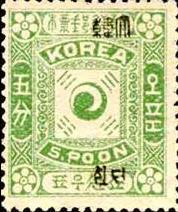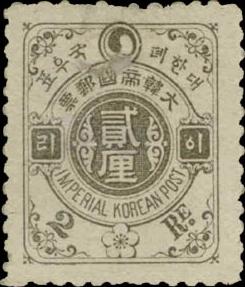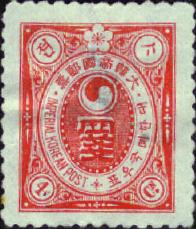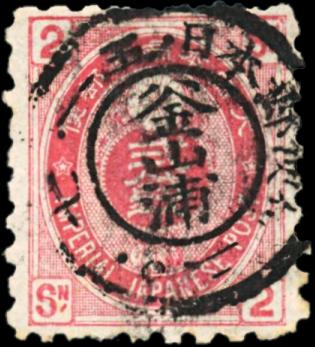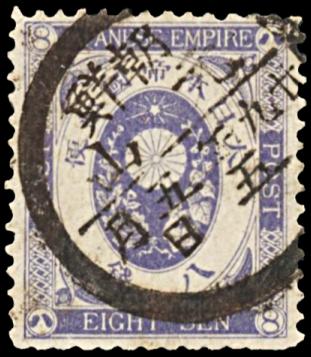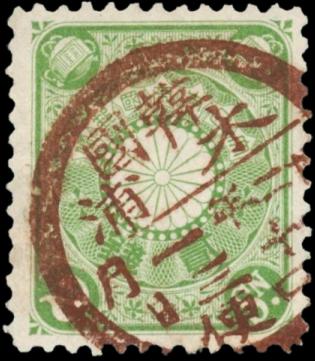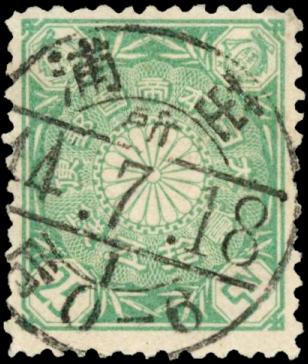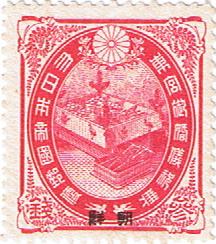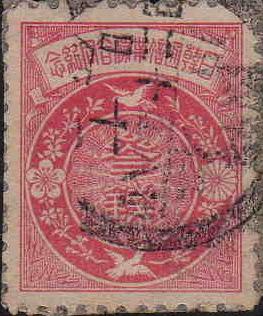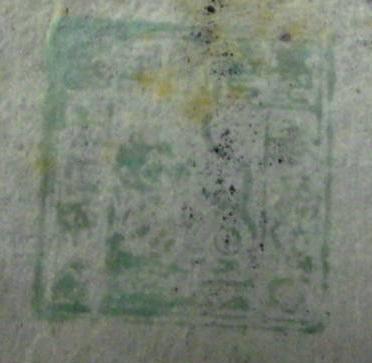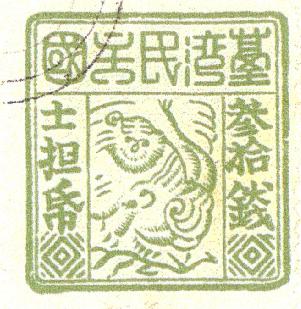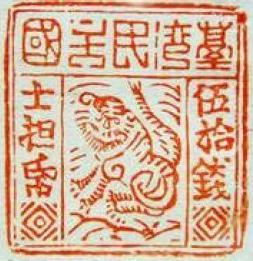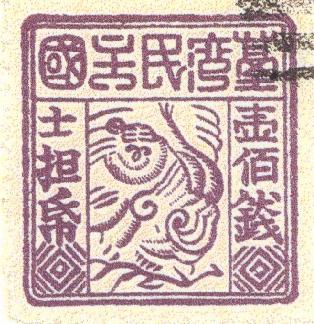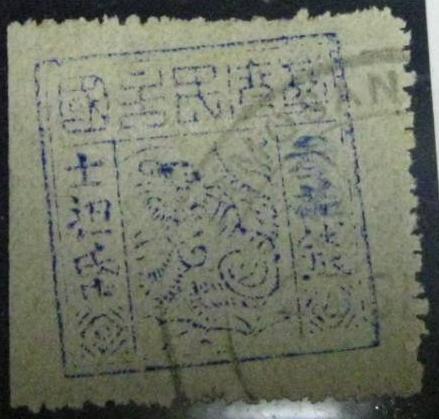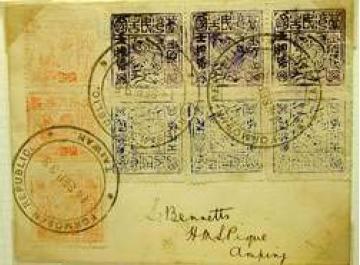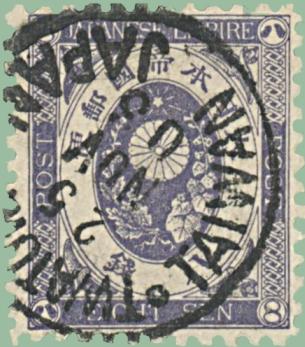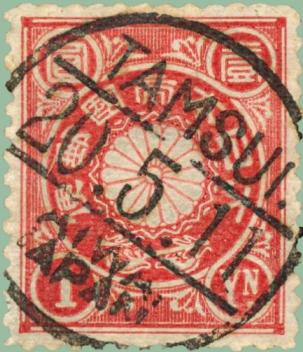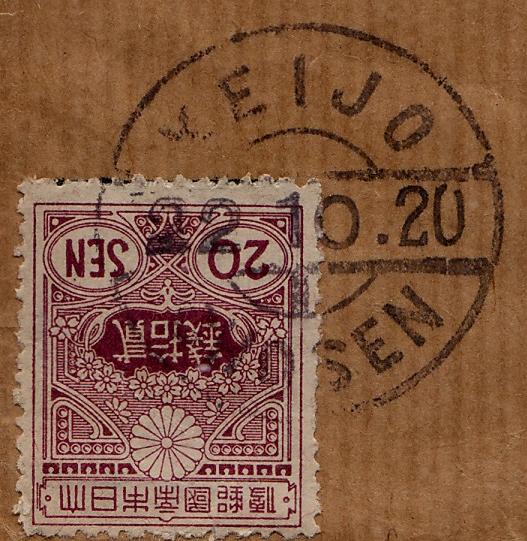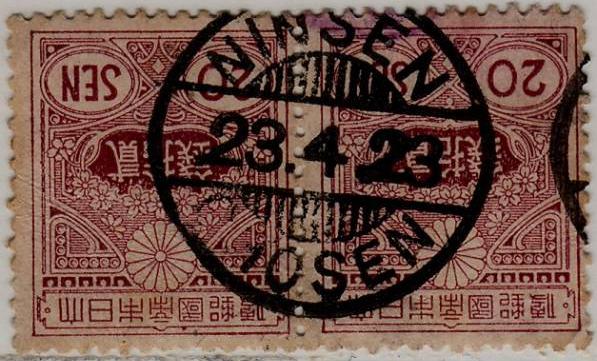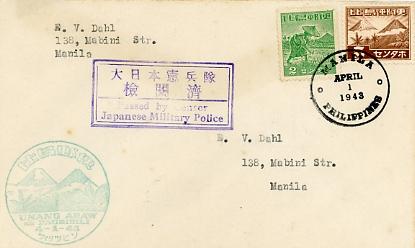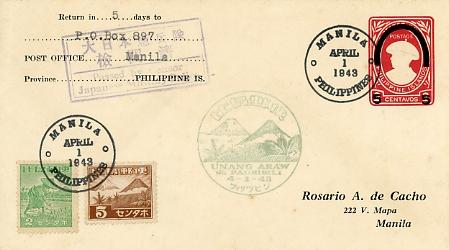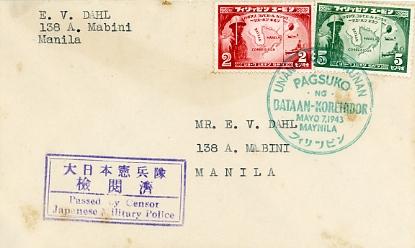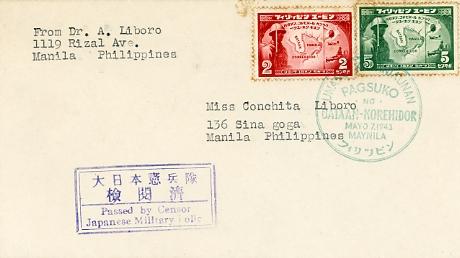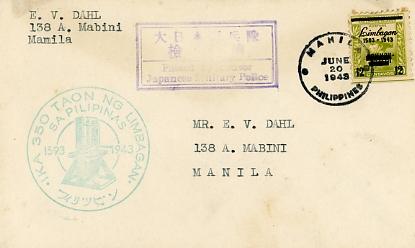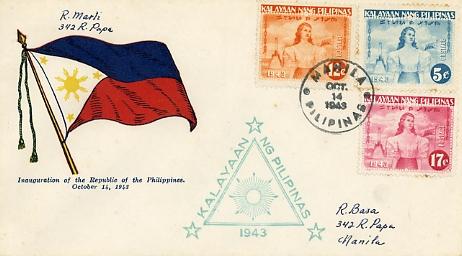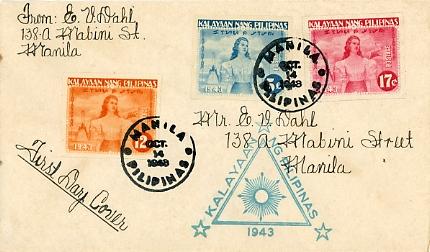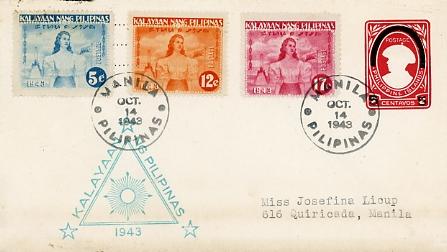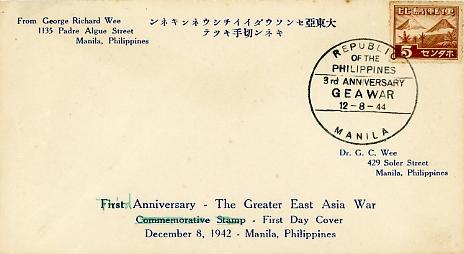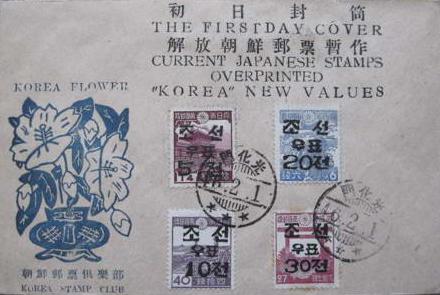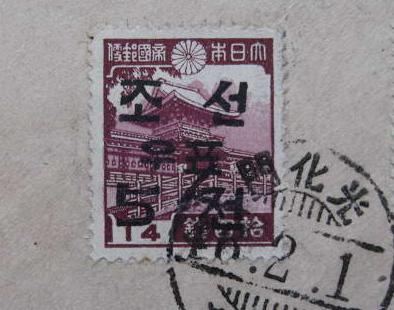The empire of postal services
Country and place names on stamps, franks, and covers
By William Wetherall
First posted 1 January 2007
Last updated 15 January 2010
East Asian posts
•
Japan
1876-
1945-
Korea
Korea 1884-
1897-
1905-1910
ROK & DPRK 1948-
China
1897-
ROC 1912-
PRC 1949-
Japan's sovereign dominion
•
Interior
|
Taiwan 1895-1945
|
Karafuto 1905-1945
|
Chosen 1910-1945
Other territories
•
Kwantung and SMR Zone
|
South Sea Islands
|
Manchoukuo
Japanese occupation stamps
•
Burma
|
Dutch Indies
|
North Borneo
|
Malaya
|
Philippines
Postwar occupation stamps
•
Divided Korea (Chosen) 1945-1948
|
Formosa (Taiwan) 1945
|
Ryukyus (Okinawa) 1945-1972
East Asian posts
Stamps are most commonly thought of as those colorful pieces of paper that are pasted to letters and parcels as tokens of payment for delivery. Less commonly seen are the stamps that are issued as proof of payment for all manner of other services, licences, and transactions for which a government collects a fee, tax, or tarriff.
Also less acknowledged have been roles that the post offices a government of one country may set up in another country, for many reasons. A country may be delegated the postal services of another country which lacks the ability to provide such a service. Or a country may set up its own postal service on the premises of a diplomatic legation, or in a territory over which it acquires control and jurisdiction through an extraterritorial treaty or lease, or after military invasion and occupation.
The following sections constitute a survey of some of the more outstanding features of postal service history in East Asia, centuring on Japan, which set the pace for Korea and China after following the lead of Western Europe and North American countries.
Franking
I am not a serious collector of such material, but my interests include also franking, within the expanding sphere of Japanese influence, of local, interterritorial, and international mail.
Today, in the age of machine processing and machine facilitated sorting and routing within and outside a given country, cancellations are more standardized. But not so long ago, local offices had more leeway in the designs of their franking stamps. Handling, also, could be very different in the case of mail being sent to other legal jurisdictions, whether within the same country or to another country.
To be continued.
Japanese posts from 1876
The history of Japan's development of its postal service is essentially that of most countries at the time, when national postal services did not yet have a very long history even in Europe or North America. Japan issued its first stamps, for domestic use, in 1871 for domestic use. From 1875 it began handling its own international mail, and in 1876 it issued the first series to bear the name of Japan.
First five years
1871 Mon (¶) denominated design modeled on 1840 English Penny Black. Stamps printed on washi (Japanese paper), called "Dragon [series] mon stamp" (³¶Øè), from 20 April 1871 (Meiji 4-3-1).
1872 Sen (K) denominated stamps of similar design called "Dragon [series] senn stamp" (³KØè), from circa April 1872 (circa Meiji 5-2).
1872 Sen denominated stamps of new design with demoniations in Arabic numbers and "Sen" in roman script top and bottom. The new design, issued from 23 August 1872 (Meiji 5-7-20), featured a cherry blossom in each corner, hence is called "Cherry blossom stamp" (÷Øè). The design also had a crysanthemum crest (eÔäÍ), which was to appear on all Japanese stamps until 1947. The graphs XÖØè (Yūbin kitte) or "Postage stamp" were conspicuously printed in the center.
1874 The cherry blossom design, but framed in a small border showing all kana in i-ro-ha order, was issued from 1 January 1974 on washi. The same design without the kana border was also printed on yōshi ([Western] ocean paper). A variation of the cherry blossom design, with a single kana appearing below the XÖØè, was issued. These single-kana designs were issued one kana at a time, in i-ro-ha order, each plate using a different kana. There were also other minor design changes, hence the numerous variations of these issues that drive serious collectors crazy.
1875 From 1 January, pursuant with the Japan-US Postal Exchange Treaty of 6 August, Japan began to handle international mail, and issued a new design of stamps, with bird designs, for this purpose.
Start of "Imperial Japanese Post"
1876 Japan's name appears on stamps for the first time as åú{é XÖ (Dai Nippon Teikoku Yūbin), which continued to appear on all Japanese stamps until replaced by ú{XÖ in 1946 (see below). Denominations were shown in Chinese graphs as before.
Most denominations also showed IMPERIAL JAPANESE POST in roman script. The 5, 6, 8, 10, and 12 sen denoninations exceptionally had JAPANESE EMPIRE plus POST.
Denominations were romanized as Rn (Rin) and Sn (Sen) for lower denominations. The 5 sen denomination had Roman number V and roman SEN, and denominations from 6 sen and higher had Arabic numbers and roman SEN. The 5, 6, 8, 10, and 12 sen issues exceptionally also spelled out numbers in roman script -- FIVE SEN to TWELVE SEN.
The series issued from 1876 are the called "Koban stamps" (¬»Øè). The series was somewhat modified in 1883, and a 1 yen stamp (Yn) was added in 1888. The 1876 series and the 1883 series are now called "Old Koban" (¬») and "New Koban" (V¬») series. These stamps continued to be issued through 1898 but remained usable.
The Koban stamps were designed by the Italian engraver Edoardo Chiossone (1833-1898), who had been invited to Japan by the Paper Money Office (¼¾) of the Ministry of Finance. The stamps were printed on new style letter presses. The Paper Money Office later became the Printing Bureau (óüÇ), then the National Printing Bureau (§óüÇ). The bureau is now a so-called "Independent Administrative Institution" of the Japanese government.
Chiossone, in Frankfurt in 1874 when Germany printed Japan's first paper money, was invited to Japan from London, where he had gone the following year to study new printing technology. He spent the rest of his life in Japan and was instrumental the Printing Bureau's development of stamp and currenty engraving and production technologies.
1884 Japan's Printing Bureau designs and produces Korea's first stamps, and over the following twenty years Japan becomes increasing involved in Korea's postal affairs (see below).
1895 Taiwan is incorporated into Japan's sovereign dominion, and as part of Japan its post offices begin to use Japanese stamps.
1899 Saw the appearance of the first new design of definitive stamps over two decades -- with a large crysanthemum crest in the center. These stamps are known as the "Kiku [Chrysanthemum] series" (eØè).
Another notable design change was the disappearance of "Imperial Japanese Post" in roman script. Roman script continues to be used for sen (or Sn) and yen denominations until 1926.
1905 Korea's postal services begin to be administered by Japan, from which point Japanese stamps begin to be used in lieu of Korean stamps (see below).
1908 The first stamp to show the face of a person is issued this year -- and the person so honored was Empress Jingū (_÷c@), who had already made her appearance on banknotes.
1910 Korea is incorporated into Japan's sovereign dominion as Chosen, from which point the merged Korea-Japan post offices on the peninsula are simply Japanese post offices (see below).
1913 In the wake of Emperor Meiji's death in 1912, an entirely new regular or "definitive" series was issued for use in the new Taishō era. This series, designed by Tazawa Masakoto (cò¹¾), an engraver at the Printing Bureau, is sometimes called the "Tazawa Old Taish%#333; series" or just the "Old Tazawa series", as a slighly revised series came out in 1924.
Watermarked versions of the Tazawa stamps began to appear from 1914 as a measure to prevent counterfeiting.
1923 The Great Kanto Earthquake of 1 September 1923 destroyed warehouses of the Ministry of Communications (üMÈ) and with them the government's stocks of stamps. The Printing Bureau was also badly damaged by the quake.
To make up for the sudden shortage of stamps, an emergency series was printed by a private company. These stamps used the name ú{XÖ rather than åú{é XÖ. The Printing Bureau resumed issuing a slighly modified version of the Tazawa series from late 1924, and use of the emergency series ended after April 1925.
1926-1945 Numerous stamps are issued during the first two decades of the Showa era, including the first airmail stamps, and stamps related to incidenets on the continent and then the Pacific War.
Japan produced the stamps for Manchoukuo after its establishment in 1932 (see below).
Japan also produced a special issue for exclusive use on Taiwan shortly after the end of World War II and before the formal surrender of Taiwan to the Allied Powers represented by the Republic of China (see below).
1945 Stocks of stamps imperial Japanese stamps continued to be used during the earlier months of the Allied Occupation of Japan.
1946 The first so-called "New Shōwa" series, issued from 1 August 1946, showed ú{XÖ (Nippon Yūbin) or "Japan Post" but continued to feature the crysanthemum crest.
1948 The crysanthemum crest, banned by Allied Occupation authorities fro use on stamps and currency, disappeared on stamps from designs issued late in 1948.
Imperial Japanese Post (1876-1945)
In the early 1850s and 1860s, Japan had permitted the establishment of extraterritorial foreign settlements in a number of treaty ports. These arrangements continued until 1899.
Japan began issuing postage stamps on 20 April 1871 (Meiji 4-3-1). However, Horst Mueller, an Austrian stamp collector who resides in Japan, makes this remark on his website at Sanrizuka.com (posted 14 October 2009, retrieved 5 December 2009).
Until 1874 mail to foreign countries was handled by consular post offices of the United States, England and France. On 1 January 1875 Japan started to use their own stamps and postmarks for mail to foreign countries, the earliest known are from 8 January 1875.
Mueller specializes in so-called "koban" (¬») stamps, which are regular series stamps issued in 1876-1879 (old koban) and 1883-1892 (new koban). Meuller's reasons for specializing in this series, and the focus of his collecting, speak volumes about the nature of serious stamp collecting.
[T]he Koban issues of Japan are fascinating, because of the many paper and perforation varieties and, most of all, because of the many different cancellation types used for domestic and foreign mail in Japan and in the many post offices Japan operated in foreign countries. For that reason I collect only used stamps, preferably on cover, used postcards and other used Koban stationary.
At present Meuller has posted shows and tells of "Postmarks with Roman Letters". These postmarks are examples of the variety of ways in which offices and officials with the authority to frank Japanese postage stamps represented the names of states, municipalities, agencies, and dates on cancellation stamps.
RESUME Since wars are fought by governments, and since can only be fought by organized socities, Most business a Governments at war go on i Dedicated collectors will pause in the middle of a war to add a new issue to their collection. Some stamp collections are built around issues and covers that reflect a war or a period of occupation after conquest.Kenneth G. Clark
The History and Postal History of Japan's Wars
Volume 1: Brief History and Postal History of the Sino-Japanese War, Boxer Uprising, Russo-Japanese War
Japan Philatelic Group Limited, May 2004
252 pages
Volume 2: The Sino-Japanese War, Russo-Japanese War, the Armies, Prisoners, Field Post Offices, Postmarks
Japan Philatelic Group Limited, 30 September 2009
450 pages
See also ú{ØèûW¤¦ï (Japan Philatelic Group Ltd.), which is related to British Society for Japanese Philately.
Japan post (1945-)
Forthcoming.
Korean posts from 1884
Like "Japan", "Korea" has changed its meanings throughout history. Since the 1884, when Korean stamps began to be issued, Korea constituted at least the seven following entitites. Here, in place of "Korea" and other such names, I have shown and (underscored the romanization of the simplest form of the name by which "Korea" was known in Korean or Japanese.
1884-1897 Great Chosŏn as independent state
1897-1905 Great Han Empire as independent state
1905-1910 Great Han Empire as protectorate of Japan
1910-1945 Chōsen as territory of Japan
1945-1948 Chosŏn south of 38th parallel under US occupation
1945-1948 Chosŏn north of 38th parallel under USSR occupation
1948-present Republic of Han in south
1948-present Demographic People's Republic of Chosŏn in north
All manner of stamps have been issued in the names of these various Koreas. The names used in English and other European languages -- in treaties and other official documents, and in popular and academic presses -- considerably varied, which has led people who consider only these languages to feel that there was no agreement as to the name of "Korea". Within East Asia, however, the names of "Korea" as written in Chinese graphs -- however they might be proncouned in Chinese, Sino-Korean, or Sino-Japanese -- the world in which such languages dominate , and greatly varied, not only in the popular press, but in treaties and other formal documents in English, French, and other European languages -- from Chosen to Corée, Corea, and Korea -- with some, but not a great deal of, consistency.
"Chosen" appeared in romanization on some of the issues. Franking varied from "Chosen" to "Corea".A lot of fuss has been made about the names for "Korea" in English. What really matters, in terms of understanding the history of "Korea" in East Asia, is how the country styled itself, and how it was styled by its most intimate Asian neighbors -- China and Japan.
Korea styled itself mainly in Chinese terms that would be read in Sino-Korean by Koreans and Sino-Japanese by Japanese. English (and other non-Sinific language) terms for "Korea" are invariably based on one or another Chinese term that has been directly morphed into English, or has come into English through morphings into other languages, European or Asia.
Here I will examine some forms of "Korean" as used on passports, banknotes, coins, stamps, maps, postcards, and woodblock prints.
Stamps of Great Chosŏn (1884-1897)
Korean entities had at times been subject to strong influence from China, and entering the last half of the 19th century, Dynastic Chosŏn could be seen as a tributary state of the Middle Kingdom. However, Korean authorities made their own decisions regarding how to deal with other countries that wanted access to Korean ports. In this respect, they were held responsible by European powers and Japan when their ships were turned away from Korean shores with force.
That RESUME
1884 Tae Chyosyŏn Guk "Corean Post" issuesIn 1884, a series of stamps was issued by the Korean government showing the name of the country as å©N (SK Tae Chyosyŏn Guk, SJ Dai Chōsen Koku) and bearing the English term "Corean Post" in English. The images shown to the right were copped and cropped from Korean Stamp Society. The following transcriptions and translations of the Chinese graphs and Korean hangul, are mine. The Chinese and Korean scripts were written right to left or top to bottom.
Description of 10-mun Chyosyŏn stamp (top right)å©N Xçâ 대죠션국우초
COREAN POST Tae Chyosyŏn Guk Uch'o (SJ Dai Chōsen Koku Yūshō) Notes 1. 죠션 (Chyosyŏn) for ©N (SJ Chōsen) is today written 조선 (Chosŏn). |
|||||||||
1885 Chyosyŏn "Korea" issuesBy the following year, the name of the issuing state was simplified to just ©N (SK Chyosyŏn, SJ Chōsen), which was represented in English as Korea. The images shown to the right were copped and cropped from Wikipedia and Kushibo (Monster Island). The following transcriptions and translations of the Chinese graphs and Korean hangul, based on the 25-poon issue, and the commentary, are mine. The Chinese and Korean scripts were written right to left or top to bottom.
Description of 25-poon Chyosyŏn stamp (left)©NX[ 죠션우표 Notes 1. The ÜE (50) poon stamp to the right has been revalued by overprinting with OE (30). 2. 죠션 (Chyosyŏn) for ©N (SJ Chōsen) is today written 조선 (Chosŏn). 3. [ (hyō) is written Ä{[. The radical Ä can be understood as a marker for some sort of measured value. Many characters were constructed by adding Ä to a character selected for its meaning and/or pronunciation. [ means a chit, ticket, ballot, or other slip of paper representing a value or choice. X[ was a Sinific term for "postage stamp". |
Imperial Korean Post (1897-1905)
Forthcoming.
1897 Overprinted Chyosyŏn "Korea" issuesIn 1897, Dynastic Chosŏn became the Empire of Korea. Until the new empire could produce stamps with its own name in 1900, it overprinted the dynastic name on older stamps with the imperial name.
Description of overprinted 5-poon Chyosyŏn stampsBoth stamps to the right are 5-poon denominated Chyosyŏn stamps first issued issued in 1885. The Chinese graphs and the Korean hangul for "Chyosyŏ" are overprinted in black or red with graphs and hangul for "Dae Han" meaning "Great Korea" -- representing "Dae Han Jyeguk" or "Great Korea Empire" as the country was renamed in 1897. The images were copped and cropped from a Siam Stamp forum posting. The posting noted that 5, 10, 25, and 50 poon stamps (posting inexplicably says "Moon") were overprinted in red (all four) and black (all but 50). |
1900 Dae Han Jyeguk / Imperial Korean Post issuesThe change in name of the issuing country reflects the fact that in 1897 Chosŏn, a state under the control of the Yi dynasty, had been reformed into the Empire of Korea, in which "Korea" is represented by Ø (SK Han, SJ Kan). Ø is framed by å - é (SK Dae - Jeguk, SJ Dai - Teikoku), in the same manner as åú{é (Dai Nippon Teikoku), which was modeled after the Sinific expression for "Great British [English] Empire" (åpé Dai Ei Teikoku). Just as Great Britain and Japan were also called p (Eikoku) and ú{ (Nihonkoku, Nipponkoku), Korea was called Ø (SK Hanguk, SJ Kankoku). The images shown to the right were copped and cropped from Wikipedia and Kushibo (Monster Island). The following transcriptions and translations of the Chinese graphs and Korean hangul, based on the 2-re issue, and the commentary, are mine. The Chinese and Korean scripts were written right to left or top to bottom.
Description of 2-re Dae Han Jyeguk stamp (left)åØé X[ 대한졔국우표 Notes 1. 졔 (Jye < Chye) for é (SJ Tei) in the name of Imperial Korea is now written 제 (Je < Che). The denomination for "Cn" (û SJ sen), written 쳔 (ch'yŏn) on the stamp to the right, is now written 천 (ch'ŏ). 2. [ is shown as usual without the Ä radical. |
1887-1911 Sino-Japanese Korean franks
Throughout this discussion, I will be referring to Korean place names, including the name of the Korean entity as a state or territory, by their Sino-Japanese readings. My main reason for doing so is to facilitate the need to view the franking of Japanese stamps, by Japanese post offices in Korea, from a Japanese point of view.
A "Japanese viewpoint" does not limit readings to Sino-Japanese. Japanese stamps used in Taiwan during the early years that it was part of Japan, for example, showed local place names in Chinese romanization. In Korea, however, place names were romanized in Sino-Japanese.
One might say that, because the post offices were in Korea, it would have been proper to romanize Korean place names in Sino-Korean. However, it was Japan's prerogative to romanize the names as it pleased. And for reasons we will probably never know, Japanese post offices in Korea romanized Korean place names in Sino-Japanese.
I say Japan's prerogative, because in point of fact Japanese post offices in Korea were essentially Japanese territory. At the time, most countries established post offices in their foreign missions, and as such they were essentially extraterritorial operations. In other words, Japanese stamps were cancelled in Korea under Japanese, not Korean, authority, for Japanese, not Korean, purposes.
My purpose here is to introduce cancellations, not stamps. The stamps are incidental to the showing of how they were cancelled.
Cancellation marks, or franks, were of broadly two kinds -- Japanese script or Romanization. Dates on Japanese franks were shown in Chinese characters or in Arabic numbers. Dates on Romanized franks were usually shown in Arabic numbers. Dates on both kinds of franks were sometimes shown in a mixture of Arabic and Roman numerals.
Japanese post offices in Korea
Japan established its first post office in Chōsen (©N SK Chosŏn), in the port city of Fusan (R SK Pusan), in 1876, after the conclusion of a treaty between Japan and Chosen that opened up the country to foreign trade. Within a few years, Japan had also established post offices in the port cities of Gensan (³R SK Wonsŏn) and Ninsen [Jinsen] (mì SK Inch'ŏn).
Japan's position in Korea, among other foreign states vying for political and commercial influence, increased. Relations between Japan and China were particularly tense, as Korea had been a quasi-tributary state in relation to China. Russia was also a contender for power in Korea.
Japanese postal operations were briefly suspended in 1894 at the outset of the Sino-Japanese War of 1894-1895, which began in Korea and was about Korea's independence. Japan's position in the Korean postal system was stronger after the war. Japan dominated the foreign post, meaning that Japanese post offices in Korea handled mail bound from Korea to other countries.
The Empire of Korea, founded in 1897, established a foreign post that was provisionally under Japanese control. This post, which began operating in 1900, used Japanese stamps overprinted with ©N -- read Chosŏn in Sino-Korean and Chōsen in Sino-Japanese. This had been the name of Korea until 1897, when the country was officially Ø (SK Hanguk, SJ Kankoku) or a variation thereof.
The Russo-Japanese war of 1904-1905, which also began in Korea and over Korea, also caused some disruption in postal services in Korea. During the war, however, Korea became a Japanese protectorate, and shortly after the war Korea delegated its foreign affairs to Japan. From this point, Japan is in control of all postal and telecommunications on the peninsula.
Korea ceases to exist in 1910 when it is annexed to Japan as the Japanese territory of Chōsen -- not Chosŏn. From this point, Chosen becomes a jurisdiction within the larger Japanese postal authority, which had already embraced Taiwan.
The Japan Philatelic Society (JPS) has a feature article in English (which I am able to find in Japanese) on "Korean Postal History -- Japanese Post in Korea". The article is an interview with Dr. Kazuyuki Inoue, MD, vice-president of JPS at the time he won a prize at DUBAI 2006 for an exhibit by this name.
Inoue was inspired to collect stamps related to the Japanese Post in Korea by former JPS president Meiso Mizuhara, who had collected and done extensive research in this field and written a book, published by JPS, called "Korean Postal History 1884-1905". this is a reference to the following publication.
´¾âx
©NßãXÖj 1884-1905
Fú{Xï¦ïA1993
448ÅAMizuhara Meisō (1924-1993)
Chōsen kindai yūbin shi 1884-1905
Tokyo: Nihon Yūshu Kyōkai, 1993
448 pages, boxed
The book is stuffed with examples of frankings on covers and stamps from the period.
The interview with Inoue concludes with the following outline of the development of the Japanese Post until Korea became part of Japan in 1910 (shown as retrieved December 2009).
|
VICISSITUDE OF JAPANESE POST IN KOREA 1876 Opening of the First J.P.O. in Pusan |
Inoue sees Korean postal history as his lifework and hopes to publish a sequel to Mizuhara's work.
Principal web sources
The following four stamps were featured in a section titled "Japanese text cancellations in Chosen" (©NÌa¶útó) in a longer blog article dated 29 October 2009 by a blogger called Hirojiiji. In the introduction to the article, the writer said that the following week he would be going to a hospital for a checkup.
In the next post, dated 6 November 2009, the blogger reported that he was closing shop because of the results from of the medical examination. The next post, dated 21 November 2009, announced that the blog would vanish at the end of the year -- and highlighted the line VºÍȸA½¾Á¦éÌÝEEEE -- meaing "Old soldiers never die, they just fade away . . . ."
The blog was clearly that of a dedicated, serious, and deeply informed philatelist who apparently specialized in French stamps and cancellations but had broad interests in other areas of stamp collecting. Otsukarasama deshita.
1887 Chosen Fusan frank
Stampåú{é XÖ Dai Nippon Teikoku Yūbin FrankRY (SJ Fusanho) Fusanho [Fuzanpo] is Sino-Japanese for Sino-Korean Pusanp'o, meaning the port of Pusan, on the southeast of the southern tip of the Korean peninsula, now part of ROK. The port is one of the most accessible to ships plying the straits between Korea and Japan from either the northwest coast of Kyushu or the extreme southwest coast of Honshu. |
1896 Chosen Gensan frank
StampJAPANESE EMPIRE / POST Frank©N / ³R (SJ Chōsen / Gensan) Gensan [Genzan] is Sino-Japanese for Sino-Korean Wŏnsan, a port on the east coast of the northern part of the Korean peninsula, in the arm pit, as it were, of the Eastern (Japan) Sea. The region is now in DPRK. The stamp is part of the New Koban (V¬») series issued between 1883-1892. This stamp was issued 10 March 1888. It is valued at about 500 yen used, but the frank increases is value to about 3,000. The lower part of the cancellation is empty -- i.e., the classification of the mail is not shown. Presumably it was registered mail because the postage for such mail would have been 8 sen. |
1899 Kankoku Mokuho frankAll graphs are printed to read right to left.
Stampåú{é XÖ Dai Nippon Teikoku Yūbin FrankØ (SJ Kankoku) Mokuho [Moppo] is Sino-Japanese for Sino-Korean [Mokp'o] on the southwest coast of the southern tip of the Korean peninsula, now in ROK. A port was opened in the city, which faces the Yellow Sea, on 1 October 1897, a couple of weeks before the official start of the Empire of Korea on 13 October 1897. The stamp is part of the Kiku (e) series issued from 1899-1908. It is worth only about 50 yen used. However, this stamp, with this frank, has been valued at 42,000, since the stamp was issued on 1 January 1899, and the frank shows that it was used barely too weeks later in Korea. The received story is that the Mokuho post office had run out of 2-sen stamps, the most common value, at the end of the previous year. Accordingly, it was quickly supplied with sheets of the new issue. If so, this stamp represents the debut of the issue in Korea. |
1911 Satsuho frankAfter Korea was annexed to Japan as Chosen, a ©NÇ (Chōsen kyoku) or "Chosen bureau" of the Japanese postal service was established in the territory. Local post offices in Chosen were restructured to process mail as Japanese mail, hence the name of Chulp'o as the (sho) or local post office within the Chosen operation. In other words, after Korea became Chosen, a part of Japan, franks began showing only the local office name.
Stampåú{é XÖ Dai Nippon Teikoku Yūbin FrankûY (SJ Satsuho) Satsuho is Sino-Japanese for Sino-Korean Chulp'o on the westcoast of the southern half of the Koran peninsula, now in ROK. The stamp is part of the Kiku (e) series issued from 1899-1908. This stamp is worth about 300 yen used. However, the value of the stamp with this frank was valued at 12,000. |
1900-1901 Chosen overprints of Japanese stampsIn 1900, some issues of standard Japanese stamps were overprinted with N© (SJ Chōsen, SK Chosŏn) at the bottom of the stamps. The graphs were printed in either red ink (some) or black ink (most) to be read right to left. The significance of the "Chosen" overprint is that, since 1897, "Korea" was officially "The Empire of Korea" (åØé ) or just "Korea" (Ø ). Contemporary franking also showed Ø (SK Hanguk, SJ Kankoku). Yet the overprint on the stamp was "Chosen". Fourteen values of the standard Kiku Series (eØè), from 5 ri to 1 yen, were issued with N© overprints on 1 January 1900. The series itself was issued in eighteen values, some of which had variations, between 1899 and 1908.
The 3-sen "Wedding of Crown Prince" ({̲¥) commemorative was also issued with a black N© overprint on 28 April 1900 -- the day the commemorative was generally issued. The image to the right was copped and cropped from a Yahoo! Auction seller who was asking a minimum 3,500 yen for the stamp, in mint condition, said to be worth 23,000 yen. Stamp catalogs state that the commemorative was issued on 10 May 1900, the day Crown Prince Yoshihito, later known as Taishō, married Kujō Sadako. Hirohito, later known as Shōwa, was born on 29 April the following year. Customary use of "Chosen" and "Shina"The overprinting of "Chosen" on stamps for use in Japanese offices in Korea is probably best explained by the simultaneous issue of "Shina" overprints for use in Japanese offices in China. Three series of standard Japanese stamps were overprinted with "Shina" between 1900 and 1919 for use in Japanese offices in China. The Crown Prince commemorate was also issued with a ßx ("Shina" overprint on 28 April 1900. "Shina" was of course the customary, not the formal, Japanese name for "China". In treaties, China was referred to as å´ (Treat Ching), but also å´ (Great Ching Country) and å´cé (Great Ching Empire). The Sino-Japanese War of 1894-1895 is usually called "Japan-Ching War" (ú´í SJ Nisshin sensō). "Chosen" had been the name of the country since the start of the Yi dynasty in the late 14th century. Over the subsequent centuries, Japanese sources typically called the country Chosen. Japan was certainly not opposed to "Kankoku" since it had supported, even advocated and been the model for, the restructuring and renaming of the country that came in 1897. The use of "Chosen" on the overprinted stamps three years later most likely reflects customary usage rather than anything political. Use beyond discontinuation dateUse of the Chosen overprints was discontinued as of 31 March 1901, the last day of that fiscal year. In other words, the overprints were used for only 15 months. Apparently, thought, some such stamps were accepted for use after this date. Takahashi Stamp Co. posted images of a registered-mail cover with two 5-sen red-overprinted stamps that bore franks with the Chinese characters Ø / é and a date that is not clear but according to the company represents 35-8-29. The franks thus appear to read "Kankoku / Keijō / [Meiji YMD] 35-8-29" and mean "Korea / Seoul / 28 August 1902". The locality of the recipient, brushed in black on the front of the envelope, is a Kumamoto prefecture village. The locality of the sender, written on the back, was "Kankoku Keijō Chōdō" (Ø é·´). Also on the back was the date "8th month 29th day".
|
Merged Japanese-Korean post (1905-1910)
On 1 April 1905, Korea and Japan signed an "Agreement concerning the delegation [to Japan] of Korea's communications organs" (ØÊM@ÖÏõjÖXæÉ Kankoku tsōshin kikan itaku ni kan suru torikimegaki).
The 10-article agreement transferred to Japan "the control and administration of the post, telegraph and telephone services in Korea (except the telephone service exclusively pertaining to the Department of the Imperial Household)" (Article 1) -- until which time "in the future an ample surplus exists in the finances of the Korean Government [when] the control of their communications services may be returned to the Government of Korea" (Article 10) (Chung 1919, pages 215-218).
1905 stamp commemorating communication service mergerJapan completed its takeover of Korea's communication facilities by 1 July 1905, on which date a stamp commenorating the merger was issued.
The stamp to the right is titled úØÊMƱ¯IO (Nik-Kan tsūshin gyōmu gōdō kinen) or "Japan-Korea communication services merger commemoration". The graphs in the center show its denomination to be QK (san sen) or "3 sen". In the spirit of commemorating the "merger" of the postal services of Japan and Korea on the peninsula, the stamp does not show that it was issued by åú{é XÖ (Dai Nippon Teikoku Yūbin) or "Great Japan Imperial Post". Instead it shows the crysanthemum of Japan's imperial court on the right and the hibiscus of Korea's imperial court on the left. |
Chinese posts from 1897
Forthcoming.
Imperial Chinese Post (1897-1912)
Forthcoming.
Republic of China post (1912-)
Forthcoming.
People's Republic of China post (1949-)
Forthcoming.
Stamps in Japan's sovereign dominion
Forthcoming
Interior (prefectures)
Forthcoming
Taiwan as part of Japan
Taiwan was formally part of Japan from 1895 to 1952, and subject to Japanese control and jurisdiction from 1895 to 1945.
1895-1945
When Japan took possession of Taiwan in 1895, it met with some resistance from Chinese on the island who had declared Taiwan to be an independent country called äiàs¯å (T'aiwan minchu kuo) or "Taiwan democratic state". The government called the country "Formosan Republic" in English, judging from the eight or so denominations of stamps it reportedly issued between August and October 1895 (see "1895 Formosan Republic stamps" box below).
The Ching dynasty government in China, which had ceded Taiwan to Japan, did not, however, recognize the self-proclaimed government in Taiwan. And ROC, which succeeded the Ching dynasty from 1912, continued to regard the cession of Taiwan to Japan as legitimate under the terms of the Shimonoseki Treaty of 1895.
The short-lived Taiwan nationalist government is viewed by some Taiwanese nationalists today to have been the origin of what they believe should be internationally recognized as an independent "Taiwan" -- contrary to claims by the People's Republic of China that Taiwan and other territories under ROC control and jurisdiction are parts of "China" as a PRC entity. Such nationalists feel that ROC should not have been allowed to occupy Taiwan in 1945, much less should PRC have any say in its affairs today.
However, not until after the formation of the Allied Powers in 1942, by which time Japan no longer recognized ROC, did ROC formally begin to maintain that Japan had "stolen" Taiwan from China -- hence the wording of the 1943 Cairo Declaration, which ultimately mandated that, under the terms of surrender in 1945, Japan would lose Taiwan, and Taiwanese would be treated as "liberated" people.
From 1895 to 1945, imperial Japanese stamps were used on Taiwan. Franks on international mail from Taiwan usually identified Taiwan as part of Japan (see "Taiwan franks when part of Japan" box below).
1945-present
Japan formally surrendered Taiwan to the Republic of China (ROC), representing the Allied Powers, on 25 October. However, from 21 October 1945, the Japanese government on Taiwan issued a series of stamps of very simple design for use only on Taiwan.
There appear to have been seven denominations -- 1, 3, 5, 10, 30, 40, and 50 sen, and 1, 5, and 10 yen. The sen denominations had large arabic numerals on the stamps. The yen denominations were of other designs and romanized the graph for yen as EN.
Some denominations of these stamps were used until about 3 November. ROC began overprinting the special series with د / äiàsÈ meaning "ROC / Taiwan province" -- until it could introduce its own stamps from XXXX.
1895 Formosan Republic stampsWhen Japan took possession of Taiwan in 1895, it met with some resistance from Chinese on the island who had declared Taiwan to be an independent country called äiàs¯å (T'aiwan minchu kuo) or "Taiwan democratic state" -- which called itself "Formosan Republic" in English. The TMK (FR) government is reported to have issued eight or so denominations of stamps between August and October 1895. The values I am able to make out are 30 (ÒE), 50 (Þ\E), and 100 (ã) chien (K). The two copies of the 30 chien stamp appear to be differently colored. The blue (from Yahoo Japan) and the green (from Yahoo Taiwan), if not from differenly colored printings, may reflect exposures to different conditions after printing. Some of the details on the two copies of the 50 chien stamps -- such as in the graph for "state" ( ) -- appear to be different. The unused version (from Dreyer) is more angular, the cancelled version (from Yahoo in Japan) rounder. The image of the unused 50 chien stamp represents a crop from what appears to be a perforated copy that has not yet been separated from a larger sheet. |
|||||||||
1895 Formosan Republic coverUsed stamps with clear cancellations are generally more valuable for social historians than crisp, clean, unused stamps. The details on original covers tell even more interesting stories. FrankingThe off-cover cancelled 50 chien stamp shown above reveals only FORMOSAN and 27 SEP. The frankings on the cover to the right fully read FORMOSAN REPUBLIC / TAIWAN. Their date appears to be 14 SEP 95. AddressThe address on cover appreas to read: [ ? ] Bennetts Anping (À½), also known as Anpeng, was the port for the city of Tainan (äì) on the southwest coast of Taiwan. Anping, Tainan, and the surrounding area were the center of most intercourse between Taiwan and Chinese, Dutch, and Japanese interests until the 19th century, when other parts also began to figure in the islands affairs. Tainan was the seat of the Formosan Republic. It was also the site of the last stands of many of its supporters. Nearby Anping was the port through which some of its leaders escaped to China. HMS Pique was the British warship that conveyed an offer of conditional surrender from Liu Yung-fu («i 1837-1917), the second and last head of the Formosan Republic, and the Japanese command at Makung in the Pescadores, on or about 10 October 1895. The Japanese command demanded unconditional surrender, but Liu refused, and the war went on. On or about 20 October, Liu decided to abandon the garrison at Tainan, and disguised as a coolie he escaped to Amoy on a British merchant ship. A Japanese naval vessel caught up with the British ship, but the British captain, apparently displeased by what he later protested as an unlawful boarding, protected Liu's identity. By 21 October, thousands of Chinese supportors of the anti-Japanese movement, who had gone to Anping seeking safety in its relative neutrality, were surrendering their arms, partly through the encouragement of the port's British and other European residents. SourcesThe clear copy of the 50 chien stamp, and the cover posted to Anping, were copped and cropped from a PDF version a paper entitled "Taiwan's Evolving Identity", presented by June Teufel Dreyer, of the University of Miami, on 17 July 2003, at the Woodrow Wilson International Institute for Scholars, Washington, D.C. Dreyer did not, in her paper, comment on the stamp or the cover, except in her endnotes, where she remarkes that she was "indebted to Lee Ming-liang for supplying photographs of the two stamps . . . , obtained through the good offices of Chuang C. Chiueh, U.S. National Institutes of Health." All of the above commentary on the stamps and cover are mine, developed from visual examination and other web and printed sources. |
|||||||||
Taiwan franks when part of JapanA variety of franks were used on Taiwan as part of Japan. Franks on main within the sovereign empire used Chinese graphs. Franks on international mail showed romanized place names and Gregorian calendar dates. Taiwan place names were usually romanized according to their conventional romanizations based on Taiwanese pronunciations. However, some names began to be romanized according to their Sino-Japanese pronunciations. |
||
1903 Twatutia Taiwan Japan frankStampJAPANESE EMPIRE / POST FrankTWATUTIA / TAIWAN / JAPAN Twatutia was the Taiwanese romanization of åâj埕, read Tataoch'eng (Dadaocheng) in Mandarin, and Daitōtei in Sino-Japanese. A major trading port, it was incorporated into Taihoku (WG Taipei, PY Taibei) city in 1920. The stamp is part of the 1883-1892 New Koban series. The owner speculates that this frank cancelled both the 8-sen stamp and a 2-sen stamp on a cover sent overseas. It is ordinarily valued at 500 yen but this copy went for 58,000 yen. |
||
1911 Tamsui Taiwan Japan frankStampåú{é XÖ Dai Nippon Teikoku Yūbin FrankTAMSUI. Tamsui (W ), another relic of Taiwanese romanization, is known as Tanshui (Danshui) in Mandarin and Tansui in Sino-Japanese. Tamsui was a town on the coast near the mouth of the Tamsui river on the northern tip of Taiwan not far from Taihoku. By the time this frank was used, post offices on Taiwan had come to use a common frank design of this kind, called "come style" (ù^) because of its likeliness to small combs with round backs (the lines across the frank marking the teeth of the comb). This stamp, in the 1899-1907 Kiku series, is worth 500 used, but with this frank it was valued at 60,000 yen. The owner is particularly proud of this stamp because it was featured in eØèÌã (Kiku gitte no jidai), published in 1999 by the Japan Philatelic Society (ú{Xï¦ï) in commemoration of JAPEX '99. |
Karafuto
Forthcoming
Chosen
Forthcoming
1910-1945 Chosen frankings on Japanese stampsBoth of the Chosen frankings to the right are on 20-sen Tazawa series granite paper (Ñ) stamps issued between 1914-1925. A single used stamp, with a commonplace cancellation, such as Tokyo, would be worth only 350 yen. However, the stamp franked Keijo in Chosen, on a cover of registered mail to Canada, was offered for 24,000 to 36,000 yen on Yahoo! Auction in late 2009. The same dealer offered the pair of stamps franked Ninsen [Inch'ŏn] in Chosen for a minimum bid of 5,800 yen. Even before Korea became a part of Japan called Chosen, Japanese stamps had come into use for posting mail from entity to other states and territories. Stamps were generally franked with "Chosen" but there are also examples of "Corea" frankings. When franked in alphabetic script, Korean placenames were generally shown in Sino-Japanese romanizations. Hence é was usually Keijo but sometimes was Seoul. RESUMERomanized frankings of Japanese stamps on mail posted from Korea as a part of Japan called Chosen varied somewhat. The vast majority of cancellations I have seen show "Chosen". Only a few show "Corea" -- which has to be regarded as an anomally in the manner in which the local postal authorities thought Chosen should be called in "English" on a frank intended for mail posted to a foreign address -- meaning an address written in alphabetic script. Some mail from Chosen has a second "I.J.P.O" or "Imperial Japanese Post Office" frank for an office in Manchoukuo or China through which the mail was routed to, say, "England". All of the mailed covers and postcards shown by Kushibo's site are of material sent to foreign addresses outside Chosen -- meaning addresses writtin in an alphabetic script -- to places like Canada, England, France, and Austria. |
Other territories under Japan's total or partial jurisdiction
Forthcoming
Kwantung Leasehold, South Manchuria Railway Zone, Manchuria
Forthcoming
South Sea Islands Mandate
Forthcoming
Manchoukuo
Forthcoming
Japanese occupation stamps
Forthcoming
Burma
Forthcoming
Dutch Indies
Forthcoming
North Borneo
Forthcoming
Malaya
Forthcoming
Philippines
Some people collect postage and revenue stamps as a hobby that is easily set aside by the demands of daily life. A few, though, collect stamps with a zeal that rivals their concern about food, clothing, shelter, sleep, and love.
Because postal services have become so vital, they continue during all but the most disruptive of wars, and are and given high priority during foreign military occupations. The production, circulation, and use of new issues -- and their collection in the form of commemorative first-day covers -- quickly followed Japan's invasion and "liberation" of the Philippines as an American Commonwealth.
The Philippines as an object of Japanese liberation
The Great Pacific became a veritable chessboard on which the United States and Japan began to maneuver with each other from the time Commodore Matthew Perry's black ships forced Japan to enter into an unequal treaty with the United States in . The Allied Powers called "Checkmate" with the Potsdam Declaration of 1945, and Japan balked for only a few days before it accepted the unconditional terms of surrender.
America's purchase of Alaska from Russia in 1867 was followed by Japan's swap with Russia of its interests in Karafuto for the Kurile islands in 1875. America's annexation of Hawaii and its acquisition of the Philippine Islands in 1898 came in the wake of Japan's acquisition of Taiwan in 1895.
Japan's acquisition of Karafuto and Russia's Manchurian interests in 1905, its annexation of Korea as Chosen in 1910, its acquisition of jurisdiction over Germany's Pacific islands as a result of World War I, its role in the founding of Manchoukuo in 1932, and its invasion and occupation of parts of China from 1937, spurred the United States to take its own initiatives against Japan in the form of economic sanctions.
The year leading up to Japan's attack on Pearl Harbor and the invasion of the Philippines on 8 December 1941 witnessed serious of war preparations by both Japan and the United States. The preparations were evident in the push-and-shove that took place in Southeast Asia in mid 1941.
In 1940 and 1941, the United States, and then Great Britain and the Netherlands, began supporting the Republic of China in its struggle against Japan, by imposing sanctions on Japan in the form of embargoes of oil, iron, and other strategic products.
Japan had signed an anti-Comintern pact with Germany in November 1936, a pact of alliance with Germany and Italy in September 1940, and a neutrality pact with the Soviet Union in April 1941. The 1940 and 1941 pacts had important consequences in Greater East Asia.
As France had capitulated to Germany in June 1940, the tripartite alliance of September 1940 gave Japan leverage over French interests in Indochina. The French government in Indochina, which continued to operate under the Vichy French government in occupied France, was forced to permit Japan to occupy Tonkin, and otherwise facilitate its attempts to further isolate the ROC government, which had taken refuge in Chungking, and which Japan no longer recognized.
The neutrality pact of April 1941 allowed the USSR to focus on its fight for survival with Germany, but it also gave Japan license to focus its limited resources on China with less concern about Soviet actions against Japan's interests in Northeast Asia. And in July 1941, Japan took control of a number of French military facilities French Indochina and formed an alliance with France regarding Indochina's defense.
Within days after Japan's moves in French Indochina, the US froze Japanese and Chinese assets in the United States. Chinese assests were also frozen -- at the request of the ROC government of Chiang Kai-shek, in exile in Chungking, for and the bulk of China's finances were under the control of the government of Wang Ching-wei in Nanking, with which Japan had signed an alliance in March 1940.
The United States also established the US Army Forces in the Far East (USAFFE) and appointed Douglas MacArthur. MacArthur's mission was to defend the Philippines and other US interests in the region. Local Philippine forces, many units reactivated in response to what the US considered an emergency sitation, were also placed under MacArthur's command.
The US territory called "Philippine Islands" in 1898 had became a US commonwealth called the "Philippines" in 1935. The constitution of the Philippines defined the new country as a republican state, and declared that sovereignty resided in its own people defined as its citizens.
Though legalliy now "another country" in the eyes of the United States, the Philippines would remain a US protectorate until it gained full state sovereignty in 1945. In the meantime, Filipino citizens would remain US nationals and, as such, aleges of the United States. And the United States, responsible for the defense of the Philippines, would retain rights to mobilize and command local military forces.
Stamps in the Philippines
That RESUME
Overprinting and surcharging of stamps in use before the occupation was done in the Philippines by the Bureau of Printing in Manila. Some new issues were designed and produced by the Bureau of Printing in Tokyo and sent to the Philippines.
IKA 350 TAON NG LIMBAGAN
SA PILIPINAS
1593 1943
tBbs
Crossed out:
Overprinted: Limbagan 1593-1943
Crossed out:
Revalued at: 12 Centavos
Frank: Manila, Philippines, June 20 1943
Commemorating, in Taglog, the 350th anniversary of local printing, showing an image of a printing press in center of green commemorative frank.
Inauguration of the Republic of the Philippines. October 14, 1943 Specially printed envelop with flag Commemorative frank: KALAYAAN / NG PILIPINAS / 1943 Frank on stamps: Manila \ 14 Oct. 1943 / Pilipinas Stamps KALAYAAN NANG PHILIPINAS 4, 12, 17 centavos Tagalog was used for stamps commemorating the inauguration of the puppet republic of 1943. These carry a Later issues have REPUBLIKA NG PlLIPINAS and Jose Rizal, Father Jose Burgos, and Apolinario Mabini. Less than 60 postage stamps were issued in this period, most of the later ones locally printed on gumless paper.Postwar occupation stamps
Forthcoming
Stamps in divided Korea (Chosen) under US and USSR (1945-1948)
Forthcoming
1946 "Liberated Chosen" overprintsUnder the US Army Military Government in Korea, in the southern zone of Korea, provisional "Korean" stamps were issued by overprinting stocks of Japanese stamps. These temporary issues show the name of the entity as ðú©N -- "Liberated Chosen" if translating into English -- using the term for the entity that had been used by Japan in English. The images shown here -- of the first day cover of a series of Japanese stamps, overprinted and revalued, issued on 1 February 1946, and of one of the franks on the cover -- were copped and cropped from Snuma Website Freeboard, the Seoul National University Medical Alumni website in the United States, as posted in hangul on the snumc1965 alumnus BBS by Chum Jee on Father's Day 2007-06-17. The representations, transcriptions, and translations are mine.
Coverú Overprinting조선 / 우표 Frankingõ»å (K Kwanghwamun, J Kōkamon) Note that the Chinese graphs on both the stamp and the frank read from right to left, while the hangul on the overprints read left to right. |
Stamps in Formosa (Taiwan) under ROC
Forthcoming
Stamps in Ryukyus (Okinawa) under US administration
Forthcoming
